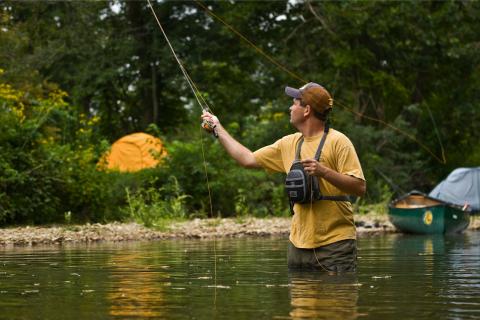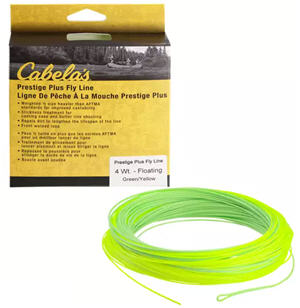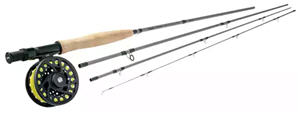
Perhaps the most common question asked between fly anglers is, “What rod are you fishing?” Fly rods are the focal point of a fly angler’s arsenal – the rock stars of your fishing gear. Successful fly fishers won’t simply know the brand and name of the rod they are fishing; they will know why their rod makes them more likely to catch fish. And though modern-day fly rods are packed with a variety of different technologies, understanding them doesn’t have to be difficult.

Fly Line Weight is What Casts the Fly
Because artificial flies have low weights and densities, rods are designed to cast weighted fly line. The weight of the fly line makes it possible to cast an unweighted fly, unlike conventional fishing where the weight of the lure carries out the line. A rod’s weight rating denotes the weight of line that should be used with it. If you have a five-weight rod, it’s made to be fished with a five-weight line.
When determining what rod weight you should use, there are several things to consider. Of them, the type of water you’re fishing (the distance of your casts), prevalent weather conditions, fly size and fish size are most important. Typically, the larger the fish, heavier the fly, larger the body of water and stiffer the wind, the heavier weight rating your fly rod should have.
A List of Suggest Fly Rod Weights for Popular Fish Species
- Panfish: suggested fly rod weight 0-4
- Average-Size Trout: suggested fly rod weight 4-6
- Smaller Trout in Small Creeks: suggested fly rod weight 0-4
- Smallmouth Bass: suggested fly rod weight 5-8
- Largemouth Bass: suggested fly rod weight 5-9
- Carp: suggested fly rod weight 6-10
- Steelhead: suggested fly rod weight 7-9
- Salmon: suggested fly rod weight 8-10
- Northern Pike and Muskie: suggested fly rod weight 8-12
- Grayling: suggested fly rod weight 3-5
- Bonefish, Redfish: suggested fly rod weight 7-9
- Striped Bass, False Albacore: suggested fly rod weight 8-12
- Peacock Bass, Golden Dorado: suggested fly rod weight 8-12
- Tarpon, Roosters, Giant Trevally: suggested fly rod weight 10-12
- Mahi-Mahi: suggested fly rod weight 10-14
- Bluefin: suggested fly rod weight 12-14
- Sailfish and Marlin: suggested fly rod weight 14
Fly Rod Lengths - Longer Rods, Longer Casts

Fly rods are generally longer than conventional rods, but can vary greatly in length. Shorter rods, 6-8 ft., are excellent for small creeks with many obstacles to cast around. Longer rods, 8-10 ft., work well in larger bodies of water where lengthier casts are necessary to reach fish. These types of rods are ideal for nymphing waters with complex currents, as they help you reach over contradicting flows and obtain a better drift. Rods longer than 10 ft. are typically spey or switch rods.
Tip: Start fly fishing with the affordable Cabela's Bighorn Fly Combo. This fly rod is crafted using strong, sensitive 24-ton carbon graphite. The Bighorn blanks meet Cabela's GI technology standards with a forgiving moderate action that's perfect for beginner and intermediate fly casters.
Flex and Action of the Fly Rod Impact How the Rod Casts
Flex refers to how deeply the rod bends during casting. For the most part, fly-rod flex ranges are divided into three categories:
- Tip-flex – Only the first third of the rod flexes when casting.
- Mid-flex – The rod flexes to the halfway point while casting.
- Full-flex – The rod flexes all the way to the grip during casting.
A fly rod’s action classification is determined by how quickly the rod loads and unloads. While this is heavily influenced by line weight – heavier fly lines cause rods to unload slowly – action classifications are given based on how rods cast with the line they were manufactured for (i.e. a five-weight rod with a five-weight line). If a rod loads and unloads quickly, it’s fast action. If a rod loads and unloads slowly, it’s slow action.

The flex and action you want depend on your casting stroke as well as the environment and conditions you’re fishing. Slower rod actions with more flex cater to a deliberate casting style, while faster actions with less flex fit well with fast, powerful casting strokes.
Though reasonable distance and accuracy are obtainable with nearly any well-built rod, fast-action rods are known for extreme distance and powering flies and lines through stiff winds. Slow-action rods are ideal when delicate presentations to skittish fish are required
Tip: If you want to try fly fishing but are unsure as to what to buy, the all-inclusive Cabela's Prestige Fly Outfit takes the guesswork out of gearing up properly. This fly outfit has everything you'll need – performance-matched rod and reel, line, flies, tools, and gear holders. All you need to do is hit the water.
Fly Rod Materials Pros & Cons
As fly-rod technologies continue to advance, more materials are being used to develop them. Each rod material has its advantages.
Graphite Fly Rods: The introduction of graphite to the fly-fishing world in the early ’70s was an absolute game changer. For the first time, manufacturers could make rods that were light, strong, extremely sensitive and very durable. Since then, manufacturers have continued to improve graphite rods, and today some of the highest-performing rods are graphite.
Nano-Silica Resin Fly Rods: This technology pushes the benefits of carbon fiber (graphite) to new levels. Hundreds of thousands of nano-silica particles are infused into the resin that fills the gaps between the cross sections of the carbon fibers. This makes the resin a structural component of the rod rather than just a fill-in, making it stronger and more powerful.
Boron Fly Rods: Originally used for aerospace design, it has since been applied to fly rods with success. Added to graphite, boron makes a rod stronger, lighter and more sensitive.
Fiberglass Fly Rods: For a time, the graphite boom made fiberglass rods nearly obsolete. Recently, however, fiberglass rods have made a comeback, carving out their own niche as an important part of the fly-fishing industry. Inherently slower than graphite rods, fiberglass rods cater to a slower casting stroke. They fish very well in close quarters, as they load with much less line out than most graphite rods do. Many anglers find it not only more effective to go after small fish in small streams with fiberglass, but also more enjoyable because an 8" brook trout on a fiberglass rod can feel like a 14" cutthroat on a graphite rod.
Bamboo Fly Rods: As the traditional rod material, bamboo rods will always hold a special place in the fly-fishing community. While bamboo has a slightly faster rate of recovery (action) than fiberglass, it still creates slower rods than carbon-fiber materials. Some like bamboo strictly for the nostalgia. Others like it for the same reasons they like fiberglass. Bamboo rods are typically heavy when compared to graphite and fiberglass, but a finely made bamboo rod is a pleasure to cast.
Tip: Shop quality fly rods at basspro.com
Rod Grip Styles Control the Fly Rod
Like all of the other components of a fly rod, the grip you should choose depends on what you are most comfortable with and the conditions you will be fishing. Cigar and ultrafine grips have a distinct down taper. They are typically used with light rods. Half-wells grips are used primarily in midweight and midlength rods. They have a less distinct front taper than cigar and ultrafine grips. Full-wells and reverse half-wells grips are often used on midweight to heavyweight rods. They make it easier to add power to your casting stroke with your thumb because of their reverse taper.
Many rods incorporate a fighting butt just underneath the reel seat. The fighting butt lets you comfortably anchor the rod against your body to ease arm fatigue during long battles. Your rod will be heavier, but if you think your days will be spent fighting large fish, a fighting butt is a useful asset.
Multi-Piece Fly Rods Meet the Needs of Many Anglers
Today’s fly rods are typically made in two to seven pieces. The more pieces a rod has, the more convenient it is to store. Historically, ferrules interrupt the transfer of energy throughout the rod (the more ferrules, the deader the action). However, advancements in technology have lessened these issues, making a four-piece or seven-piece rod perform more like a two-piece rod.
Either sleeve-over ferrules or spigot ferrules connect the separate pieces of a rod. Sleeve-over ferrules, in which one section slides over the tip of the one below it, are the most common. Spigot ferrules involve an insert that extends out of the bottom section, allowing the top section to slide over.
While both ferrules are used on all rod sizes, sleeve-over ferrules are more often used on faster rods, as they have an innate stiffness that works well with fast actions. Spigot ferrules are used more often in smaller, slower rods – especially fiberglass rods, where the consistent taper supplied by spigot ferrules is useful.
The Guides on a Fly Rod Affect It's Performance
Guides are metal loops attached to the rod using thread and a light epoxy. They guide the fly line up and out of the rod. There are three types of guides: tip-top, running and stripping guides. The tip-top guide is the guide on the very end of the fly rod; running guides populate the middle of the rod; the stripping guide is the first and sometimes second guide on the rod.
Stainless steel or plated-wire guides are commonly used. However, higher-end rods often use alloys such as nickel or titanium.
Fly Rod Reel Seats Matter by Keeping Your Fly Reel Snug to the Rod
There are several types of reel seats. The right one for you depends heavily on the environment you’re fishing. If you are fishing saltwater, it’s vital that you choose a reel seat with saltwater-safe components ( i.e. aluminum, titanium, carbon fiber etc.). You don’t want a wood insert in a saltwater environment – a reel seat with a walnut insert may be pleasing to the eye, but after extended use on saltwater it will deteriorate, becoming both less aesthetically pleasing and less effective at keeping your reel snug to your rod. The same goes for all other types of wood.
Another thing to consider is how the reel is “locked” to the reel seat.
Uplocking: The locking nut turns toward the grip. This leaves more room between the bottom of the reel and the bottom of the rod, adding length to the rod’s fighting butt.
Downlocking: The locking nut turns toward the butt. Because it locks down, it works with gravity instead of against it, making this system the least likely to slip.
Slip Rings: Two rings slip over your reel foot to hold it in place. A common concern with this type of reel seat is the difficulty of slipping the rings over the reel foot. Don’t be worried. Over time, the cork molds to the reel foot, making this easier and creating a custom fit that holds your reel snug.
- 23645 views

